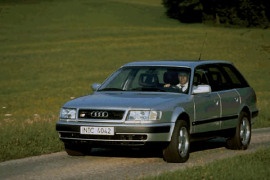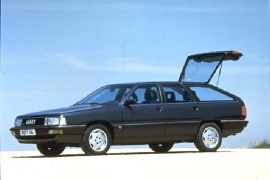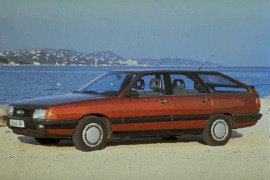AUDI 100/ 200 Avant Models/Series Timeline, Specifications & Photos
First production year: 1983
Engines: Gasoline, Diesel
Body style: Wagon (station wagon, estate, combi, touring)
Audi introduced the last generation of the 100 model in 1991. It was available in two body versions: the sedan, and the station wagon, also known as the Avant.
By 1991, the German carmaker had already progressed enough to disrupt the supremacy of BMW and Mercedes-Benz on the market. The front and all-wheel-drive systems, the price policy, and the good manufacturing quality convinced the customers that Audi became, finally, a premium carmaker. Moreover, the 100 series was one of the most important cars in its lineup, competing with the W124 mid-size sedan from Mercedes-Benz and the 5 Series from BMW.
Audi used the form-follow-function concept when it designed the 1991 100 model. It was more aerodynamic and showed a more composed image with a tilted front fascia and squared headlights. The long-roof version used the same Avant designation as its predecessor, but it was a full-legit station wagon, not a liftback or hatchback vehicle. It was the moment when Audi decided to offer a similar cargo capacity as its leading contenders, dropping the idea of a more appealing, yet less usable, shape. Thus, the 100 Avant offered 390 liters (13.8 cu. ft.) of space, which could have been extended to up to 1,310 liters (46.3 cu. ft.) with the rear bench folded.
Inside, the manufacturing quality exceeded all the customers' expectations. Soft surfaces and a well-built dashboard left no room for squeaks and rattles. The center stack didn't look like it was added at the last moment, showing a unitary design with the rest of the cabin. On top of that, the dashboard sported a long, curved visor for the instrument cluster, also covering three extra gauges.
Under the hood, Audi installed a vast choice of gasoline and diesel engines. It also offered the car with front- or all-wheel drive.
AUDI 100 Avant (C4) 2.0L 4AT FWD (115 HP)
AUDI 100 Avant (C4) 2.0L 5MT FWD (101 HP)
AUDI 100 Avant (C4) 2.0L 5MT FWD (115 HP)
AUDI 100 Avant (C4) 2.0L quattro 5MT AWD (115 HP)
AUDI 100 Avant (C4) 2.3L 4AT FWD (133 HP)
AUDI 100 Avant (C4) 2.3L 5MT FWD (133 HP)
AUDI 100 Avant (C4) 2.3L quattro 5MT AWD (133 HP)
AUDI 100 Avant (C4) 2.6 quattro 5MT AWD (150 HP)
AUDI 100 Avant (C4) 2.6L 4AT FWD (150 HP)
AUDI 100 Avant (C4) 2.6L 5MT FWD (150 HP)
AUDI 100 Avant (C4) 2.6L quattro 4AT AWD (150 HP)
AUDI 100 Avant (C4) 2.8L V6 4AT FWD (174 HP)
AUDI 100 Avant (C4) 2.8L V6 5MT FWD (174 HP)
Audi created the 200 range on the same 100 lineup, but with more powerful engines and a slightly restyled bodywork to compete against Mercedes-Benz E-Class and BMW 5 Series.
The German carmaker from Ingolstadt tried to cut some corners in its march to the premium segment. While it wasn't sure that the recipe would work, it was the easiest way to do it. In some ways, it worked since it offered better engines only packed in slightly changed bodyworks. Even though it looked very similar to its 100 sibling, the 200 and the 200 Avant sported some differences.
There were some minor changes on the car's exterior compared with its lesser equipped sibling. At the front, the 200 featured bumper-mounted turn signals, while its sibling had them in the headlights. The 200 didn't sport any lamps on the front fenders, and the doors featured grab-handles instead of flush ones. In the Avant version, the back panel was also different. The 200 sported broad taillights extended from one side to another, creating an upscale look.
Inside, Audi installed a rounded instrument cluster that raised and descended over the dashboard. A wood-veneer adorned the front side of the panel and incorporated three center vents in the middle and two on each side, next to the front doors. The carmaker extended the instrument panel above the center stack, adding three additional gauges. As for the trunk, it kept the same 390 liters (13.7 cu-ft) with the rear seats up, which could have been extended up to 1,310 liters (46.3 cu ft).
Audi installed a range of inline-five engines under the 200's hood paired with either a five-speed manual or a four-speed automatic, depending on the market. Power went either to the front wheels or in all corners.
The third generation of the Audi 100 was the generation that lost its wagon version. Instead of a traditional station wagon, Audi offered a sort of hatchback, naming it the Avant. It was built on the same technical platform as the rest of the lineup, but the entire rear part of the vehicle's bodywork was changed.
The demand for classic station wagon vehicles on the upper market was not in high demand, but sometimes more trunk space was appreciated, and Audi gave a smart answer with this fastback bodywork. The total trunk space was 390 liters (13.7 cu-ft) with the rear seats up and it could be extended up to 1310 liters (46.3 cu ft). The interior room was enough for five adult passengers.
A great innovation for the year it was launched was the fully galvanized body, and that made it rust-resistant. The 10 years anti-rust warranty was also a good proof of quality. Another interesting innovation for the vehicle was the quattro all-wheel-drive system and the procon-ten protection system in case of an accident.
The pneumatically controlled central locking system relied on vacuum rather than electric actuators. The entry level engine was a 1.8-liter unit while the top model was a 2.3-liter unit turbocharged. An automatic transmission was offered as an option.
AUDI 100 Avant (C3) 1.8L 3AT FWD (75 HP)
AUDI 100 Avant (C3) 1.8L 3AT FWD (90 HP)
AUDI 100 Avant (C3) 1.8L 4MT FWD (75 HP)
AUDI 100 Avant (C3) 1.8L 4MT FWD (90 HP)
AUDI 100 Avant (C3) 1.8L quattro 5MT AWD (90 HP)
AUDI 100 Avant (C3) 2.0L 3AT FWD (115 HP)
AUDI 100 Avant (C3) 2.0L 5MT FWD (115 HP)
AUDI 100 Avant (C3) 2.2L 3AT FWD (138 HP)
AUDI 100 Avant (C3) 2.2L 5MT FWD (138 HP)
AUDI 100 Avant (C3) 2.2L quattro 5MT AWD (138 HP)
AUDI 100 Avant (C3) 2.2L Turbo 3AT FWD (165 HP)
AUDI 100 Avant (C3) 2.2L Turbo 5MT FWD (165 HP)
AUDI 100 Avant (C3) 2.2L Turbo quattro 5MT AWD (165 HP)


